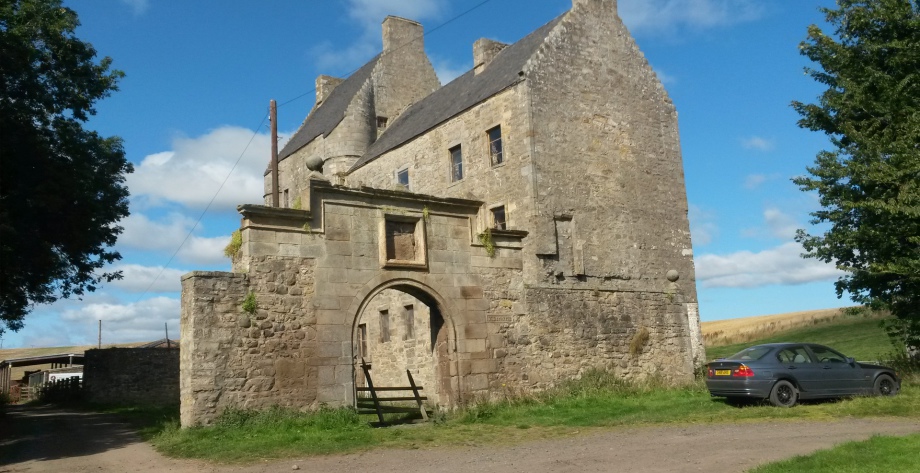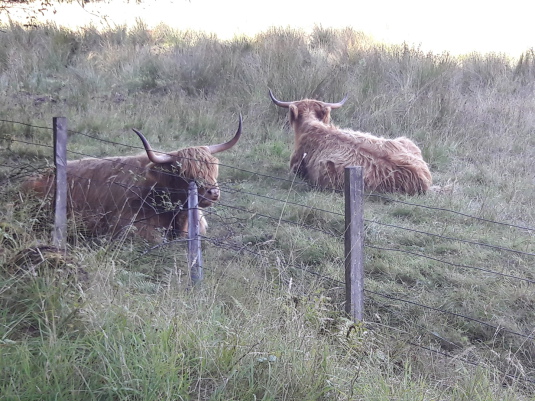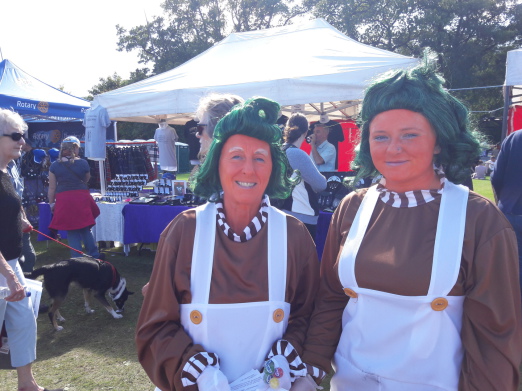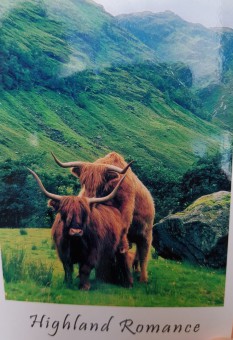
Saturday, September 8th - Aberfeldy, Craigh na Dun, Queen's View, Pitlochry and Falkirk
Or: Where is the man in a kilt???
On Saturday the focus was on the visit of the Highland Games in Pitlochry, the only Highland Games within reach during our stay in Scotland. The other destinations of the day were practically planned around this fixed date.
Pitlochry is a big stretch, about 2 hours drive, north of Glasgow, so we wanted to leave in time to be there at 12.30 p.m. at the beginning of the Heavy Weights (a kind of heptathlon of the disciplines). That's why we didn't go to the breakfast room of the day before, where we had needed quite a long time for breakfast, but to the café Tinderbox directly under our apartment, a bit more plainly furnished, but with a good and cheap breakfast. Thus we could start early, in the best weather and at least as good a mood. But one thing was still missing: Karin finally wanted to see a man in a "real" kilt. But in a modern big city such as Glasgow these were rather scarce, in the middle of the back row of seats where she sat, she probably didn't have an optimal view and every time one of the others saw a kilt bearer and called out "Man in a kilt", we heard "where? - oh, it was over again", connected with a big disappointment of hers. This expression "man in a kilt" developed like another to a winged word on our journey, which again and again provided cheerfulness in our round. We could promise Karin with a clear conscience that she would see some or rather many men in a kilt at the Highland Games that day, but until then it took quite a while and her patience was put to a hard test. We first went on the Motorway M8 in northwest direction towards Edinburgh, before we came on the A9 and later on smaller side roads north. I had to explain that A's are in Great Britain the same as in Germany the federal roads (we call them B's from "Bundesstrasse" while A's are standing for our "Autobahn", the british motorway), from the single-digit numbers, so the very important and very often very well developed roads, sometimes even four-lane, to the three-digit A's and the county roads, the B's, which is usually also shown in the smaller width and poorer quality, down to single-lane roads with passing points, which the Scots always use very friendly and in good behaviour, we have not actually experienced wrangling among drivers.
As I had often practiced while driving on my own, it was also agreed within our group that we would stop spontaneously at a beautiful, interesting view on call of one of us, as long as the traffic and the road situation allowed it, to enjoy the view and take pictures. Our first stop of that kind was after a curvy ascent through a small forest, where we had overtaken a cyclist. We simply stopped after leaving the forest on a straight road section, no car behind us, in front of us a beautiful panorama that caused Ah's and Oh's:
We had gotten in after taking pictures and just wanted to drive off again, when it did a giant blow in the back of our car and we noticed - after a moment of great shock - that the cyclist who had been overtaken a while before had actually bumped us on the back! He had probably fought his way up meter by meter, always looking down, his eyes linked to the white line, and was at least as freaked as we were. Fortunately, neither he nor his bike nor our car had visible damages (I got out and checked!), we accepted his apology and he could continue his way by bike, while we laughed so hard that we barely couldn't calm ourselves. And so the cyclist, whenever we saw another one, became another running gag and we will not forget this event for life - and the cyclist probably not as well.
The next nice point we discovered was the small town Aberfeldy with its Tay Bridge, a beautiful old bridge over the river Tay, which is controlled by traffic lights. Stopping on the bridge is strictly prohibited! Since we had reacted too late, we turned round after the bridge and drove back to take some nice pictures from the other side. Here we also discovered the monument for the Black Watch, whose tartan Conny and I wear in our clothes. A wonderfully peaceful, beautiful place.
Up there in the mountains there were even more nice places to stop and enjoy:
Located on our way to Pitlochry, I wanted to show my girls the "real" Craig na Dun, whose location I had found only a few days before on Stuart Morrison's fan page outlanderlocations.com. In the past, I'd often discovered many valuable online hints for its shooting locations, especially last year for season 3. Last year, I was on a bus tour also visiting a place that we thought was the location for this famous circle of stgones, but this turned out to be the wrong place and I've now really thoroughly researched not to follow a misinformation again and it has been confirmed now! This certainly magical place is located south of the water reservoir east of Kinloch Rannoch, on a farm on a small winding road through the mountains. A sign at the gate confirms that this truly is the "real" Craigh na Dun and even more a real prehistoric site, which is also marked with real stones sticking out of the ground. You are allowed to enter the closed off private ground and are asked politely on the sign at the gate for good behaviour which was a matter of course for uw. The only obstacle besides the gate is a cattle grid, over which we walked very carefully and full of joy to the magical place ahead, from where we had a wonderful view over the valley and the northern lakes. Of course we had to dance a little and dream a little before we made our way back to the car and already speculated on how long it would take to commercialize this place as many others before. Maybe 1 or 2 years only, there might be also a cash box there... We hope not.
We hit the road again, past the first real Highland cattle - Highland coos - these held probably just a digestive sleep -
Passing Kinloch Rannoch on a very long, very winding road north of Loch Tummel to our next lookout point, the traditional Queen's View, named after Queen Victoria, who visited him many, many years ago. We were already later than we actually wanted to be and luckily found a parking place directly at the small stairway leading to the viewing platform. The best weather possible really gave us a royal view,
which we enjoyed until Christina excitedly told me that a man in uniform was writing a ticket to our car! Since British parking tickets famously are not exactly known to be cheap, I hurried to get back to the car as soon as possible and found a parking attendant in an orange vest with a block in his hand, but from then on fortunately, the whole thing cleared up quite quickly. We were standing in the area that buses can use to turn around, except that there were no buses at that time. I explained to the friendly man that we would be immediately gone again, while parking there had been a few more cars, beside which I had placed myself without further ado and had not come thereby at all on the idea not to be allowed to do this, we had also been in some kind of haste. The poor man fights every day again and again for order on "his" parking lot, which we could certainly understand.
From Queen's View it was only a few more miles to Pitlochry. The way to the festival area led us through the picturesquely beautiful village, which has also won several placings in the competition "Britain in Bloom", which roughly corresponds to our German "Unser Dorf soll schöner werden" and when you drive through, you immediately understand the reason. The beautiful white and light brown cottages with black frames and the street lamps etc. are decorated all over with hanging baskets full of flowers, it is a real feast for the eyes that attracts many tourists every day.
The festival area lay behind the place on a huge meadow, we paid the entrance fee from the car and got - with some pleading for a disabled parking and a little persistence - a conveniently located parking place right next to the first attractions. A principle that we would use often during the next days. It was already after 13 o'clock and the games had been in full swing for a while.
Around a big rectangular field in which different sports competitions for children and adults took place, there was a big oval for longer distance competitions and bicycle races. There was also a roofed dance stage for the dance competitions and an area for the pipe bands to march up. On the outside, there were various booths offering food, drinks and treasures of all kinds, mostly typically Scottish. There was only one natural grandstand on one side for sitting down and a few beer benches placed along the oval, mostly occupied with people sitting there for hours, most people had brought folding chairs etc. with them - of course we didn't have anything like that with us, how could we? A big crowd of spectators in best sunshine and the strong men were just fighting with a bowl on a bar, some kind of hammer throwing. While looking around and shopping, we tried to find out when the Tossing the Caper would take place and I heard in several places that this had already happened as the first of the disciplines of the Heavy Weights! I couldn't believe it, no - I wouldn't believe it at all, because this was the most important thing for our Karin on this very day, maybe on the whole tour! Persistent as I can be, I asked some more people; a nice man at the Rotary booth wanted me to be a member, and he told me he had seen Tossing the Caper before, as well as one or two other viewers whom we asked. But I didn't want to give up yet and tried to get the detailed program somewhere, asked further until somebody sent me to the principal of the games, to the superintendent in the main building, a nice elderly lady, who showed me a detailed program and also explained helpfully, in which order the caper of the heavy weights would take place. The program didn't show times, just numbers and order, but she advicsed it might take place at about 16 o'clock. So I was finally able to give the all-clear and we could enjoy the rest of the afternoon, with food from the stalls (fish & chips, juicy burgers and strawberries with waffles) and the purchase of more or less vitally important souvenirs.
Scottish lasses - are they meant to represent fairies ???
We also met this wonderful gentlemean in full Highland dress, including the ribbon to his pony tail. He explained this was the tartan of Culloden and he was already 94 (!) years old. Absolutely admirable!
One of the group disciplines is also tug-of-war, which is strictly supervised by 3 referees so that the fighters do not sit down and thus increase friction. The last one in the row wraps the rope around the (usually quite voluminous) body, often padded with a cushion, deep embrasures are made in the lawn and therefore after each round they shift somewhat laterally. The lawn looked like freshly ploughed afterwards...
And finally, we saw the Tossing the Caper what we all longed for so much, each participant having 3 attempts. The primary objective is to toss the caber so that it turns end over end, falling away from the tosser. Ideally it should fall directly away from the tosser in the "12 o'clock" position. The distance thrown is unimportant.
After this discipline, we decided that we had seen the most important thing and set off. Since we had parked so well, we were immediately at the car and also immediately again down from the area. But we wanted to have another quick look at the beautiful little town Pitlochry and stopped in the centre of the village at some souvenir shops for about a quarter of an hour. This is where I found this postcard:
The next destination on our way home was Falkirk, a long way to the south, most of it on the motorway. Already from a distance we saw the Kelpies, the two big metal horse heads, but on the other side of the highway M9. Nevertheless, it was a big detour to get there, a good part of it we were stuck in traffic because we had to pass a football stadium and the access was blocked because a game was coming up. Finally we arrived at the entrance to Helix Park, yet a long way from the horses. The park around the Kelpies was free of charge, so access was free, but we asked for a disabled parking at the entrance and were allowed to drive past the barrier until far ahead - simply wonderful! I honestly loved the disabled person card of Sabine! The horse heads are a good 30 meters high and can be walked inside as part of a (chargeable) tour. According to an old Scottish legend, Kelpies are water horses and therefore fit well to the canal and the watergate at this place.
We enjoyed the wonderful evening atmosphere and the sunset, even though it slowly became quite cool. Sunlight had turnd to twilight. We decided to look for some place nearby for dinner, as it was already about 8 pm, and then drive to Glasgow later. So, with the help of our mobile phones, we found The Dutch Inn near the motorway, a well-attended family restaurant with traditional British food, where we once again ate very well, so we can recommend it.






















